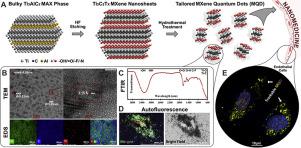当前位置:
X-MOL 学术
›
Mater. Des.
›
论文详情
Our official English website, www.x-mol.net, welcomes your
feedback! (Note: you will need to create a separate account there.)
Bioactive and trackable MXene quantum dots for subcellular nanomedicine applications
Materials & Design ( IF 7.6 ) Pub Date : 2020-11-01 , DOI: 10.1016/j.matdes.2020.109091 Alireza Rafieerad , Weiang Yan , Ahmad Amiri , Sanjiv Dhingra
Materials & Design ( IF 7.6 ) Pub Date : 2020-11-01 , DOI: 10.1016/j.matdes.2020.109091 Alireza Rafieerad , Weiang Yan , Ahmad Amiri , Sanjiv Dhingra

|
Abstract Next-generation “early transition metal carbides and nitrides” (MXene) materials have facile and economic processing with simultaneous synthesis and functionalization. Their surface characteristics can be tailored for specific applications, including energy storage, sensors, and water filtration, by adjusting synthetic parameters. Furthermore, MXene possesses excellent biocompatibility and can be designed for anticancer, antibacterial, and immunomodulatory properties. However, a major limitation facing systemic delivery of nanoparticles is ensuring successful uptake from the bloodstream into the desired site of action. An important consideration is the vascular endothelial cell (EC), which serves as the barrier between blood and organs. Therefore, cellular uptake of engineered nanoparticles by EC is important to advance their use in nanomedicine. In this study, smart zero-dimensional biocompatible titanium carbide (Ti3C2Tx) MXene quantum dots (MQD) were synthesized with specific surface modifications for subcellular nanomedicine applications. MQD were shown to be spontaneously uptaken into human ECs within 24 h of cell culture. MQD localization was observed to be highly stable during this with no significant changes seen in cell morphology. Furthermore, uptaken MQD maintained their strong autofluorescence properties at different excitation-emission wavelengths to enable post-delivery monitoring and tracking. This novel finding represents promising progress in the application of MQD for nanomedicine.
中文翻译:

用于亚细胞纳米医学应用的生物活性和可追踪 MXene 量子点
摘要 下一代“早期过渡金属碳化物和氮化物”(MXene)材料具有简单经济的加工工艺,可同时合成和功能化。通过调整合成参数,它们的表面特性可以针对特定应用进行定制,包括能量存储、传感器和水过滤。此外,MXene 具有出色的生物相容性,可用于抗癌、抗菌和免疫调节特性。然而,纳米粒子全身给药面临的一个主要限制是确保从血流中成功摄取到所需的作用部位。一个重要的考虑因素是血管内皮细胞 (EC),它是血液和器官之间的屏障。所以,EC 对工程纳米粒子的细胞摄取对于推进它们在纳米医学中的应用很重要。在这项研究中,智能零维生物相容性碳化钛 (Ti3C2Tx) MXene 量子点 (MQD) 被合成,并具有用于亚细胞纳米医学应用的特定表面改性。MQD 显示在细胞培养的 24 小时内自发吸收到人类 ECs 中。在此期间,观察到 MQD 定位高度稳定,细胞形态未见显着变化。此外,吸收的 MQD 在不同的激发发射波长下保持其强大的自发荧光特性,以实现交付后的监测和跟踪。这一新发现代表了 MQD 应用于纳米医学的有希望的进展。智能零维生物相容性碳化钛 (Ti3C2Tx) MXene 量子点 (MQD) 是合成的,具有用于亚细胞纳米医学应用的特定表面改性。MQD 显示在细胞培养的 24 小时内自发吸收到人类 ECs 中。在此期间,观察到 MQD 定位高度稳定,细胞形态未见显着变化。此外,吸收的 MQD 在不同的激发发射波长下保持其强大的自发荧光特性,以实现交付后的监测和跟踪。这一新发现代表了 MQD 应用于纳米医学的有希望的进展。智能零维生物相容性碳化钛 (Ti3C2Tx) MXene 量子点 (MQD) 是合成的,具有用于亚细胞纳米医学应用的特定表面改性。MQD 显示在细胞培养的 24 小时内自发吸收到人类 ECs 中。在此期间,观察到 MQD 定位高度稳定,细胞形态未见显着变化。此外,吸收的 MQD 在不同的激发发射波长下保持其强大的自发荧光特性,以实现交付后的监测和跟踪。这一新发现代表了 MQD 应用于纳米医学的有希望的进展。在此期间,观察到 MQD 定位高度稳定,细胞形态未见显着变化。此外,吸收的 MQD 在不同的激发发射波长下保持其强大的自发荧光特性,以实现交付后的监测和跟踪。这一新发现代表了 MQD 应用于纳米医学的有希望的进展。在此期间,观察到 MQD 定位高度稳定,细胞形态未见显着变化。此外,吸收的 MQD 在不同的激发发射波长下保持其强大的自发荧光特性,以实现交付后的监测和跟踪。这一新发现代表了 MQD 应用于纳米医学的有希望的进展。
更新日期:2020-11-01
中文翻译:

用于亚细胞纳米医学应用的生物活性和可追踪 MXene 量子点
摘要 下一代“早期过渡金属碳化物和氮化物”(MXene)材料具有简单经济的加工工艺,可同时合成和功能化。通过调整合成参数,它们的表面特性可以针对特定应用进行定制,包括能量存储、传感器和水过滤。此外,MXene 具有出色的生物相容性,可用于抗癌、抗菌和免疫调节特性。然而,纳米粒子全身给药面临的一个主要限制是确保从血流中成功摄取到所需的作用部位。一个重要的考虑因素是血管内皮细胞 (EC),它是血液和器官之间的屏障。所以,EC 对工程纳米粒子的细胞摄取对于推进它们在纳米医学中的应用很重要。在这项研究中,智能零维生物相容性碳化钛 (Ti3C2Tx) MXene 量子点 (MQD) 被合成,并具有用于亚细胞纳米医学应用的特定表面改性。MQD 显示在细胞培养的 24 小时内自发吸收到人类 ECs 中。在此期间,观察到 MQD 定位高度稳定,细胞形态未见显着变化。此外,吸收的 MQD 在不同的激发发射波长下保持其强大的自发荧光特性,以实现交付后的监测和跟踪。这一新发现代表了 MQD 应用于纳米医学的有希望的进展。智能零维生物相容性碳化钛 (Ti3C2Tx) MXene 量子点 (MQD) 是合成的,具有用于亚细胞纳米医学应用的特定表面改性。MQD 显示在细胞培养的 24 小时内自发吸收到人类 ECs 中。在此期间,观察到 MQD 定位高度稳定,细胞形态未见显着变化。此外,吸收的 MQD 在不同的激发发射波长下保持其强大的自发荧光特性,以实现交付后的监测和跟踪。这一新发现代表了 MQD 应用于纳米医学的有希望的进展。智能零维生物相容性碳化钛 (Ti3C2Tx) MXene 量子点 (MQD) 是合成的,具有用于亚细胞纳米医学应用的特定表面改性。MQD 显示在细胞培养的 24 小时内自发吸收到人类 ECs 中。在此期间,观察到 MQD 定位高度稳定,细胞形态未见显着变化。此外,吸收的 MQD 在不同的激发发射波长下保持其强大的自发荧光特性,以实现交付后的监测和跟踪。这一新发现代表了 MQD 应用于纳米医学的有希望的进展。在此期间,观察到 MQD 定位高度稳定,细胞形态未见显着变化。此外,吸收的 MQD 在不同的激发发射波长下保持其强大的自发荧光特性,以实现交付后的监测和跟踪。这一新发现代表了 MQD 应用于纳米医学的有希望的进展。在此期间,观察到 MQD 定位高度稳定,细胞形态未见显着变化。此外,吸收的 MQD 在不同的激发发射波长下保持其强大的自发荧光特性,以实现交付后的监测和跟踪。这一新发现代表了 MQD 应用于纳米医学的有希望的进展。











































 京公网安备 11010802027423号
京公网安备 11010802027423号